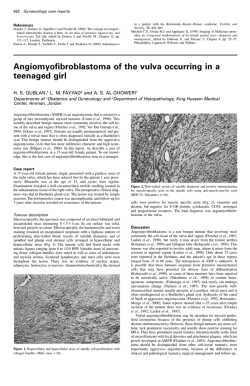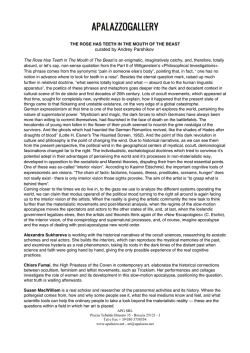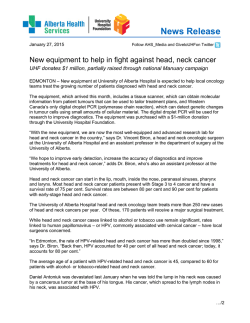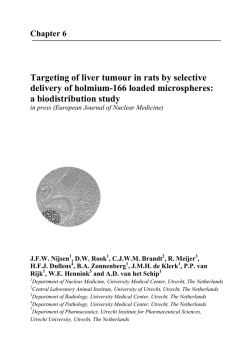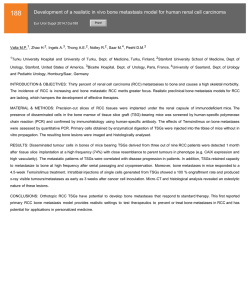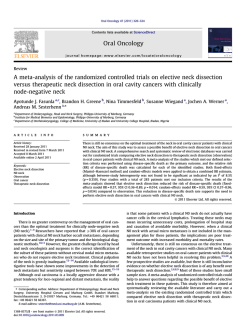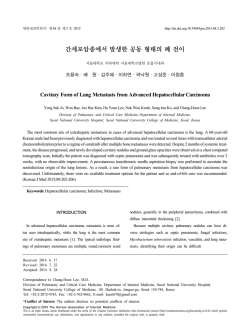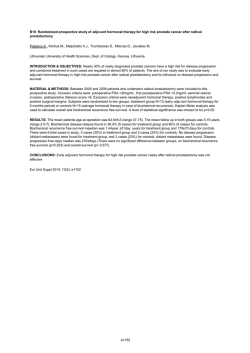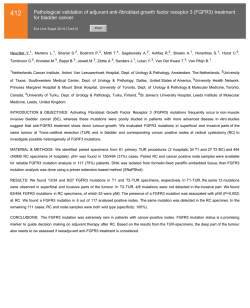
PDF (209 kB) - Oral Oncology
Oral Oncology (2007) 43, 1007– 1013 available at www.sciencedirect.com journal homepage: http://intl.elsevierhealth.com/journals/oron/ Predictive value of histopathologic parameters in early squamous cell carcinoma of oral tongue ¨ntti a,*, Timo Atula a, Jarkko Tikka b, Jaakko Hollme ´n b, Harri Keski-Sa ¨kitie a,d, Ilmo Leivo c,d Antti A. Ma a Department of Otorhinolaryngology Head and Neck Surgery, Helsinki University Central Hospital, P.O. Box 220, FIN – 00029 HUCH, Helsinki, Finland b Laboratory of Computer and Information Science, Helsinki University of Technology, Espoo, Finland c Haartman Institute, Department of Pathology, University of Helsinki and HUSLAB, Department of Pathology, Helsinki, Finland Received 3 October 2006; accepted 20 November 2006 Available online 15 February 2007 KEYWORDS Summary The clinical course of early squamous cell carcinoma of oral tongue (OTSCC) is unpredictable and various histopathologic parameters of the primary tumour have been suggested as prognostic factors to be used in clinical decision-making. We reviewed clinicopathologic data of 73 patients diagnosed with Stage I–II OTSCC. Predictive value of pathological Tstage, depth of infiltration, grade, and mode of invasion with respect to local recurrences, occult cervical metastases, and disease specific survival (DSS) was analysed. Depth of infiltration and pT-stage significantly predicted occult nodal disease, while only pT-stage predicted local recurrence. Specific cut-off value for depth of infiltration separating high-risk and low-risk patients was not found. Significant correlations between the histopathologic parameters and DSS were not found. We conclude that depth of infiltration predicted occult nodal disease but its value in clinical decision-making is limited because of poor specificity when using a cut-off value that offers reasonable sensitivity for finding the patients with occult nodal disease. The risk for occult metastases and local recurrence was high in patients with pT2 tumours. c 2006 Elsevier Ltd. All rights reserved. Depth of infiltration; Tumour thickness; Tumour diameter; Grade; Mode of invasion; Survival; Occult metastases; Oral cancer; Tongue cancer Introduction * Corresponding author. Tel.: +358 50 4271589; fax: +358 9 4717 5010. E-mail address: [email protected] (H. Keski-Sa ¨ntti). d Equal contribution. The clinical course of early squamous cell carcinoma of oral tongue (OTSCC) is fairly unpredictable. For the majority of patients, surgical peroral excision of the primary tumour would be adequate treatment to cure the disease. However, 1368-8375/$ - see front matter c 2006 Elsevier Ltd. All rights reserved. doi:10.1016/j.oraloncology.2006.11.015 1008 the incidence of occult metastasis is relatively high 1–4 and despite the advances in modern imaging technology, histopathologic examination of neck dissection specimen is still the only reliable way to detect the subclinical metastases. Treatment failures with even fatal outcome can occur in patients who initially have had very small primary tumour with no clinical evidence of metastatic disease.1,4 The results of salvage treatment of locoregional recurrences are generally reported poor.4–6 Finding the patients who are at greatest risk for occult cervical metastases and poor survival is essential in the treatment planning in this patient group. This has led to the search for various histopathologic parameters of the primary tumour that would predict the clinical course of the disease. The size of the primary tumour has been shown to have prognostic significance in predicting nodal involvement and survival in patients with OTSCC, thickness of the tumour being more important than the greatest diameter.3,7–16 In some studies, the morphology of the invasive front of the tumour has had predictive value.9,17,18 Tumour grade (degree of differentiation) seems to have no value as a prognosticator.11,13,15,16,19 It has been suggested, that tumour thickness should be used to indicate tumour size in the TNM classification system instead of tumour diameter.15 However, controversy exists regarding the critical tumour thickness, or depth of infiltration, identifying the patients with high-risk of nodal involvement and poor prognosis. In previous studies of patients with OTSCC, the suggested value for critical tumour thickness (or depth of infiltration) has varied from 3 to 10 mm, being most often 4 mm.3,7–16 In a recent review including all oral cavity tumour sites the critical tumour thickness (or depth of infiltration) varied from 1.5 mm to 10 mm being most often 3–5 mm.20 The authors pointed out that the measurement technique has not been uniform in different studies and therefore the results are not fully comparable. Therefore, more studies with comparable measurement technique are needed to reach a consensus on this topic. The aim of this study was to analyse whether depth of tumour infiltration, pT-stage, mode of tumour invasion, or tumour grade predict occult metastases, survival or local recurrence in patients with Stage I–II OTSCC at our institution. In addition, we wanted to find out if a critical depth of infiltration can be found for clinical decision-making. Patients and methods Clinicopathological data of 141 patients diagnosed with OTSCC at the Helsinki University Central Hospital (covering an area of 1.4 million inhabitants) between 1992 and 2002 were reviewed. The local Ethics Committee approved the study protocol. Only patients with tumours clinically defined as T1/T2 N0, original histopathological material available for review and a clinical follow-up data with a minimum of 24 months or until death were included in the study. Seventy-three patients were eligible for the inclusion. All patients were surgically treated with curative intent. Hospital records were reviewed and data on patient characteristics, treatment, histopathology, and follow-up were collected. The dates and causes of death were provided H. Keski-Sa ¨ntti et al. by Statistics Finland (a national agency of population statistics). The histopathological paraffin sections of each patient were reviewed by a single, experienced Head and Neck pathologist (I.L.) and depth of infiltration, grade, greatest diameter, and mode of invasion of the primary tongue tumour were re-analysed. Mode of invasion was classified into one of three fundamental categories: pushing-border, diffuse or destructive. Depth of infiltration was measured from the level of the adjacent normal mucosal surface to the deepest portion of the tumour invasion in the tongue musculature using a field arrow measurement system provided by the microscope manufacturer. Measurements were expressed at an accuracy of 0.1 mm. We also intended to analyse the resection margins. However, many patients had first had excisional biopsies or biopsies of the resection margins making determination of the full resection margins unreliable and therefore this parameter was omitted. Only re-analysed histopathological data were used in the analysis. In the case of tumours of large diameter, measuring and reconstructing the greatest tumour diameter from histopathological sections of previously dissected surgical specimens is less reliable than the original measurement. Therefore original histopathologic data were used in these cases. Re-analysis of data on tumour diameter was carried out only when original data were not available. According to the pathologically analysed tumour diameter, the tumour was classified as pT1 (620 mm) or pT2 (21–40 mm). In patients who had not had an elective neck dissection (END), occult neck disease was defined as a histologically proven neck metastasis detected during the follow-up without failure at the primary site. Cervical metastases in patients with recurrent primary tumour were not considered occult metastases, because the nodal spread may have occurred after the initial treatment. In patients who had had an END, occult neck disease was defined as presence of microscopic disease on the histopathological examination of the neck dissection specimen. One patient with prophylactic neck irradiation only was not taken into account when assessing the correlations between histopathological parameters and occult metastases. Statistical analysis In order to compare the difference between two proportions f1 and f2, we performed the following statistical test. If the null hypothesis is true, f1 and f2 are both estimators for the same proportion f. The pooled estimator for f is ^f ¼ n1 f1 þ n2 f2 ; n1 þ n2 where n1 and n2 are sample sizes. The test statistic is defined as follows f1 f2 z ¼ rffiffiffiffiffiffiffiffiffiffiffiffiffiffiffiffiffiffiffiffiffiffiffiffiffiffiffiffiffiffiffiffiffiffiffiffiffiffiffiffiffiffiffiffiffiffiffi ; ^f 1 ^f ð1=n1 þ 1=n2 Þ which is approximately normally distributed with zero mean and unit variance.21 The Wilcoxon rank-sum test can be used in the comparison of two populations.21 It is especially sensitive to differences in location, thus, the null hypothesis is that the Predictive value of histopathologic parameters in early squamous cell carcinoma of oral tongue medians of populations are equal. Since the test is nonparametric, no assumptions on parametric distributions of populations are made. The Pearson’s coefficient of correlation q defines the strength of linear dependency between two random variables X and Y.21 The value of correlation coefficient is in the range q 2 [ 1, 1] and the values of q near 1 or 1 indicate strong linear dependency. It was used to illustrate the dependency between the depth of infiltration and the greatest diameter. The Kaplan–Meier method was applied in the analysis of disease specific survival (DSS) of two populations. The different follow-up times of the patients were taken into account, i.e. the patients whose follow-up was less than 5 years were censored. In the survival curves, the tick marks represent the time when one patient was censored. The difference of two survival curves was statistically tested using log-rank test.22 The analysis of separating patients with and without occult metastases based on the depth of infiltration was carried out using the bootstrap re-sampling procedure. The accuracy of the statistical estimates can be assessed using the bootstrap without making any assumptions of underlying probability distributions.23 Let (x1, . . ., xm) and (y1, . . ., yn) indicate the measurements of the depth of infiltration of the patients with and without the occult metastases, respectively. For a given cut-off point c, the proportion of true negatives f0 is the proportion of yj, j ¼ 1; . . . ; n being less than c and the proportion of true positives f1 is the proportion of xi, i ¼ 1; . . . ; m being greater than c. The bootstrap replications f0 and f1 are calculated from the bootstrap samples ðx1 ; . . . ; xm Þ and ðy 1 ; . . . ; y n Þ. The bootstrap samples are randomly drawn with replacement from the original data (x1, . . ., xm) and (y1, . . ., yn), that is, some original data points may appear zero times, some once, some twice, etc. in the bootstrap sample. The re-sampling procedure is repeated B times, which produces B bootstrap replications f0 and f1 . These replications formulate the empirical distributions of f0 and f1. The medians of the bootstrap replications f0 and f1 are used as estimates of f0 and f1. The accuracy of estimates can be assessed using quantiles of the bootstrap replications. The medians and quantiles are used, since they describe properly also skewed distributions and distributions with outliers. The results were considered significant when the p value was <0.05. Results Seventy-three patients met the inclusion criteria. There were 36 males and 37 females (median age 59 years, range 23–95 years). The clinical T classification was as follows: T1:n = 35 (48%), T2:n = 38 (52%). All patients were staged N0 after clinical and radiological assessment. The assessment of the cervical lymph nodes consisted of palpation only in five patients. For the rest of the patients, imaging of the neck was performed as follows: CT:n = 19, ultrasonography: n = 15, MRI: n = 34. All patients underwent resection of the primary tumour (60 without reconstruction and 13 with reconstruction of the surgical defect). In 31 patients there was no further treatment primarily. Forty-two pa- 1009 tients received elective neck treatment. The clinico-pathological characteristics of the study cohort are presented in Table 1. The overall rate of occult cervical metastases was 32% (23/72). The rates of occult metastases for patients with pT1 and pT2 tumours were 23% (11/48) and 50% (12/24), respectively (p < 0.05). Depth of infiltration and pT-stage significantly predicted occult cervical metastases. The difference between proportions of the patients with occult Table 1 Clinicopathological features of study cohort No. of patients (%) Total number of patients 73 Gender Female Male 37 (51) 36 (49) Age (y) Range Median 23–95 59 Clinical T-classification cT1 cT2 35 (48) 38 (52) Treatment of the primary tumour Resection Resection + Radiotherapy 40 (55) 33 (45) Neck treatment Observation Neck dissection Neck dissection + Radiotherapy Radiotherapy 31(43) 9 (12) 32 (44) 1(1) Tumour site Lateral border Ventral surface Tip of tongue Dorsum 61 (84) 9 (12) 2 (3) 1 (1) Mode of the invasive front Pushing border Diffuse Destructive 34 (47) 28 (38) 11 (15) Histological grade Well differentiated (G1) Moderately differentiated (G2) Poorly differentiated (G3) 24 (33) 35 (48) 14 (19) Pathological T-classification pT1 pT2 49 (67) 24 (33) Occult cervical disease Yes No Not defined 23 (32) 49 (67) 1 (1) Local recurrence Yes No 9 (12) 64 (88) 1010 Table 2 H. Keski-Sa ¨ntti et al. Different cut-off points in depth of infiltration Depth of infiltration Patients with occult Metastasis (%) No. of cases 62 mm >2 mm 2 (14) 21 (36) 14 58 63 mm >3 mm 2 (11) 21 (39) 18 54 64 mm >4 mm 5 (18) 18 (41) 65 mm >5 mm 66 mm >6 mm p value 5-year DSS (%) p value 78 81 NS <0.05 83 79 NS 28 44 <0.05 82 79 NS 6 (17) 17 (46) 35 37 <0.01 82 79 NS 10 (23) 13 (46) 44 28 <0.05 85 75 NS 0.057 Figure 1 Correlation between the depth of infiltration and the greatest diameter is 0.63 and the 95% confidence interval is [0.47, 0.75]. DSS, disease specific survival; NS, non significant. metastases was significant with different cut-off values of depth of infiltration (Table 2). Mode of invasion classified as pushing-border resulted in significantly less occult metastases than classification as diffuse (p < 0.05) but no other correlations existed between the different invasion mode groups (pushing-border vs. destructive: p = 0.29, diffuse vs. destructive: p = 0.29). Tumour grade did not have any correlation with the presence of occult metastases. The overall rate of local recurrence was 12% (9/73). Of the histopathological parameters studied, only pT-stage was found to significantly predict local recurrence. The rates of local recurrence for pT1 and pT2 tumours were 6% (3/49) and 25% (6/24), respectively (p < 0.05). Significant correlations between the histopathological parameters and survival were not detected. The differences in median depth of infiltration between different patient groups are presented in Table 3. A positive correlation existed between the greatest tumour diameter and depth of infiltration, as shown in Fig. 1. Table 3 The 5-year DSS rates for patients with and without occult metastases were 65% and 91%, respectively (Fig. 2). The 5-year DSS rates for patients with and without local recurrence were 33% and 90%, respectively (Fig. 3). Discussion Clinical and histopathological data of 73 patients with Stage I–II OTSCC treated at a single tertiary care centre according to a consensus protocol during a 10-year period were reviewed. Depth of tumour infiltration, pT-stage, tumour grade, and mode of tumour invasion were re-examined and their ability to predict local recurrences, occult cervical metastases, and survival was analysed. Depth of infiltration and pT-stage were found to correlate significantly with the rate of subclinical nodal metastases. A specific cut-off value for the depth of infiltration separating high-risk and low-risk patients was not found. These results are in concordance Median depth of infiltration No. of patients Median depth of infiltration (mm) p-value Occult neck disease Yes 23 No 49 8 5 <0.05 Local recurrence Yes 9 No 64 8 5 NS Dead of disease Yes 13 No 60 8 5 NS T-Stage pT1 pT2 4 9 <0.001 49 24 NS, non significant. Figure 2 Cumulative disease specific survival (DSS) for patients with occult metastases (dashed line) and without occult metastases (solid line) evaluated using the Kaplan–Meier method. The difference in survival was statistically significant (p < 0.01) according to log-rank test. Predictive value of histopathologic parameters in early squamous cell carcinoma of oral tongue Figure 3 Cumulative disease specific survival (DSS) for patients who had local recurrence (dashed line) and for those who did not have local recurrence (solid line) evaluated using the Kaplan–Meier method. The difference in survival was statistically significant (p < 0.001) according to log-rank test. with previous studies, in which the thickness (or depth of infiltration) 3,7,9,10,12,13,15,16 and the greatest diameter 3,12 of the primary tongue tumour have been found to predict occult neck disease in patients with early tongue tumours. The high proportion of occult metastases in patients with pT2 tumours (50%) in the present study emphasizes the importance of elective neck treatment in this patient group. Most institutions advocate END as it allows definite pathologic staging of the cervical lymph nodes. It is recommended, that levels I–IV should be removed when treating patients with OTSCC.24,25 In our study, two patients with a very superficial pT1 tumour (depth of infiltration 1.3 mm and 1.5 mm) had occult metastasis pointing out that the risk of subclinical metastasis has to be considered in practically all patients diagnosed with OTSCC. Therefore, pathologic staging of the cervical lymph nodes seems to be warranted also in patients with T1 tumours, for whom sentinel lymph node biopsy may prove to be the most suitable method instead of END.26 Due to limitations of depth and size of a biopsy specimen, a reliable estimation of the histopathological parameters necessitates the evaluation of the whole tumour block. Therefore, these parameters can reliably be applied to clinical decision-making only when the whole primary tumour has first been excised and assessed. The measurement technique of the tumour thickness, or depth of infiltration, in different studies has not been uniform. Measurements from the level of normal mucosa (depth of infiltration) 9,10,12,16 from the level of basal membrane (depth of infiltration),14 or from the surface of the tumour (tumour thickness) 15,27 to the deepest portion of the tumour infiltration have been used. In some studies the method of measurement has not been defined.3,7,11,13 Hence, the results of the studies are not fully comparable. A tongue tumour can be exofytic or more often ulcerated. The critical aspect in the growth of a tongue tumour is probably the deep invasion into the tongue musculature, in which the vascular invasion and metastatic spread are likely to occur, and not the exofytic growth. Therefore, measuring the depth of infiltration from the level of the 1011 normal mucosa provides more accurate measure on the depth of tumour infiltration in the tongue tissue for prognostic consideration than tumour thickness measured from the surface of the tumour. The measurement technique should be standardised in future studies to enable comparison of studies. Many previous studies have stated a critical tumour thickness (or depth of infiltration) separating the high-risk and low-risk patients. According to our results it seems, however, that such a clear cut-off point cannot be defined. There is a risk of metastatic disease even in patients with very superficial tumours and the risk seems to increase quite linearly with increasing depth of infiltration (Fig. 4). Thus, there is probably no clinically relevant depth of infiltration a tumour must reach before it can metastasize. In the present study, 5.5 mm depth of infiltration as a cut-off point had the best overall accuracy in separating patients with and without subclinical nodal disease (Fig. 5). As shown in Figure 5, with the cut-off point at 5.5 mm, approximately 65% of both patient groups with and without occult metastases would be classified correctly. Then, however, a considerable proportion of occult metastases are overlooked. If the cut-off point is moved downwards to increase the sensitivity, the specificity falls rapidly resulting in ‘‘at risk’’ status of many true negative necks. Thus, as a tool for clinical decision-making (elective neck treatment or not), depth of infiltration is far from optimal. We found only pathological T-stage to predict local recurrences. A considerable proportion of patients with pT2 tumours had locally recurrent disease (25%) and the outcome of these patients was quite miserable (Fig. 3). Assessment of also the resection margins would have been important, as increasing tumour size leads more often to close or involved resection margins, as demonstrated by Sutton et al. 28 In their study, the incidence of local recurrences was highly dependent on status of the resection margins. Van Es et al. 29 concluded that when excision of Figure 4 Empirical cumulative distribution functions of depth of infiltration for the patients without (solid line) and with occult metastases (dashed line). The steady increase of the curve of patients with occult metastases indicates that risk of occult metastases increases steadily with increasing tumour thickness. The significance of difference between the distributions was tested using Kolmogorov–Smirnov test (p < 0.05). 1012 H. Keski-Sa ¨ntti et al. while only pT-stage predicted local recurrences. Significant correlations between histopathological parameters and survival were not found. A specific depth of infiltration separating high-risk and low-risk patients was not found. The value of depth of infiltration in clinical decision-making is limited because of poor specificity when using a cut-off value that offers reasonable sensitivity for finding the patients with occult metastases. Conflict of interest statement None declared. References Figure 5 Proportions of correctly classified patients with either true negative necks (dots) or occult metastases (circles) with different cut-off values of the depth of infiltration used as a decision variable to recognise patients with occult metastases. The solid line with dots indicates specificity and the dashed line with circles indicates sensitivity. They are medians from 1000 bootstrap replications. At the crossing of the curves, the overall accuracy is at its best. The dotted lines represent the 16% and 84% quantiles obtained using the bootstrap method reflecting the uncertainty. a T1 or T2 primary tumour in oral tongue or floor of mouth is performed with good margins, local recurrences are rare (4%) and not linked to any other histopathologic variable. As discussed previously, we had to omit the assessment of resection margins, because these data could not be measured accurately afterwards and original data was not available in many cases. In our study, mode of invasion classified as pushing-border resulted in significantly less occult metastases than that classified as diffuse; no other significant differences were found between the proportions of patients with occult metastases in different invasion mode groups, however. This may be due to small sample size; only 11 patients had tumours with invasion mode classified as destructive. In the studies by Fukano et al. 9 and Sawair et al. 30 the invasion mode was found to significantly predict nodal metastases. With respect to tumour grade, our study confirmed many former studies, in which the grade of the primary tumour does not seem to have predictive value,11,13,15,16,19 though opposite findings have also been reported.3,12 Lack of a significant correlation, however, seems to be the general experience of head and neck cancer surgeons and pathologists alike, and the present results tend to reaffirm that view. The strength of present data lies in consistent criteria of grading applied by a single pathologist throughout the study, as well as the well-documented clinical data of a patient material from a single institution practise. In the present study, none of the histopathologic parameters examined had prognostic significance with respect to survival. This contradicts many previous studies, in which the tumour thickness or depth of infiltration, 7,8,11,14–16,27 diameter,8,14 and invasion mode 18 have been found to have prognostic value. In conclusion, depth of infiltration and pT-stage were found to significantly predict occult cervical metastases, 1. Haddadin KJ, Soutar DS, Oliver RJ, Webster MH, Robertson AG, MacDonald DG. Improved survival for patients with clinically T1/T2, N0 tongue tumors undergoing a prophylactic neck dissection. Head Neck 1999;21(6):517–25. 2. Teichgraeber JF, Clairmont AA. The incidence of occult metastases for cancer of the oral tongue and floor of the mouth: treatment rationale. Head Neck Surg 1984;7(1):15–21. 3. Byers RM, El-Naggar AK, Lee YY, Rao B, Fornage B, Terry NH, et al. Can we detect or predict the presence of occult nodal metastases in patients with squamous carcinoma of the oral tongue? Head Neck 1998;20(2):138–44. 4. Keski-Sa ¨ntti H, Atula T, To ¨rnwall J, Koivunen P, Ma ¨kitie A. Elective neck treatment versus observation in patients with T1/ T2 N0 squamous cell carcinoma of oral tongue. Oral Oncol 2006;42(1):96–101. 5. Yii NW, Patel SG, Rhys-Evans PH, Breach NM. Management of the N0 neck in early cancer of the oral tongue. Clin Otolaryngol 1999;24(1):75–9. 6. Kowalski LP. Results of salvage treatment of the neck in patients with oral cancer. Arch Otolaryngol Head Neck Surg 2002;128(1):58–62. 7. Fakih AR, Rao RS, Borges AM, Patel AR. Elective versus therapeutic neck dissection in early carcinoma of the oral tongue. Am J Surg 1989;158(4):309–13. 8. Brown B, Barnes L, Mazariegos J, Taylor F, Johnson J, Wagner RL. Prognostic factors in mobile tongue and floor of mouth carcinoma. Cancer 1989;64(6):1195–202. 9. Fukano H, Matsuura H, Hasegawa Y, Nakamura S. Depth of invasion as a predictive factor for cervical lymph node metastasis in tongue carcinoma. Head Neck 1997;19(3): 205–10. 10. Asakage T, Yokose T, Mukai K, Tsugane S, Tsubono Y, Asai M, et al. Tumor thickness predicts cervical metastasis in patients with stage I/II carcinoma of the tongue. Cancer 1998;82(8): 1443–8. 11. Al-Rajhi N, Khafaga Y, El-Husseiny J, Saleem M, Mourad W, Al-Otieschan A, et al. Early stage carcinoma of oral tongue: prognostic factors for local control and survival. Oral Oncol 2000;36(6):508–14. 12. Kurokawa H, Yamashita Y, Takeda S, Zhang M, Fukuyama H, Takahashi T. Risk factors for late cervical lymph node metastases in patients with stage I or II carcinoma of the tongue. Head Neck 2002;24(8):731–6. 13. Okamoto M, Nishimine M, Kishi M, Kirita T, Sugimura M, Nakamura M, et al. Prediction of delayed neck metastasis in patients with stage I/II squamous cell carcinoma of the tongue. J Oral Pathol Med 2002;31(4):227–33. 14. Gonzalez-Moles MA, Esteban F, Rodriguez-Archilla A, Ruiz-Avila S, Gonzalez-Moles S. Importance of tumour thickness measurement in prognosis of tongue cancer. Oral Oncol 2002;38(4): 394–7. Predictive value of histopathologic parameters in early squamous cell carcinoma of oral tongue 15. Po Wing Yuen A, Lam KY, Lam LK, Ho CM, Wong A, Chow TL, et al. Prognostic factors of clinically stage I and II oral tongue carcinoma-A comparative study of stage, thickness, shape, growth pattern, invasive front malignancy grading, Martinez– Gimeno score, and pathologic features. Head Neck 2002;24(6): 513–20. 16. O-charoenrat P, Pillai G, Patel S, Fisher C, Archer D, Eccles S, et al. Tumour thickness predicts cervical nodal metastases and survival in early oral tongue cancer. Oral Oncol 2003;39(4): 386–90. 17. Bryne M, Koppang HS, Lilleng R, Kjaerheim A. Malignancy grading of the deep invasive margins of oral squamous cell carcinomas has high prognostic value. J Pathol 1992;166(4): 375–81. 18. Bundgaard T, Rossen K, Henriksen SD, Charabi S, Sogaard H, Grau C. Histopathologic parameters in the evaluation of T1 squamous cell carcinomas of the oral cavity. Head Neck 2002;24(7):656–60. 19. Woolgar JA. Histopathological prognosticators in oral and oropharyngeal squamous cell carcinoma. Oral Oncol 2006;42(3): 229–39. 20. Pentenero M, Gandolfo S, Carrozzo M. Importance of tumor thickness and depth of invasion in nodal involvement and prognosis of oral squamous cell carcinoma: a review of the literature. Head Neck 2005;27(12):1080–91. 21. Milton JS, Arnold JC. Introduction to probability and statistics – principles and applications for engineering and computing sciences. Second ed. McGraw-Hill; 1990. 22. Kalbfleisch JD, Prentice RL. The statistical analysis of failure time data. New york: Wiley; 1980. 1013 23. Efron B, Tibshirani RJ. An introduction to the bootstrap. Chapman & Hall/CRC; 1993. 24. Byers RM, Weber RS, Andrews T, McGill D, Kare R, Wolf P. Frequency and therapeutic implications of ‘‘skip metastases’’ in the neck from squamous carcinoma of the oral tongue. Head Neck 1997;19(1):14–9. 25. Wei WI, Ferlito A, Rinaldo A, Gourin CG, Lowry J, Ho WK, et al. Management of the N0 neck – reference or preference. Oral Oncol 2006;42(2):115–22. 26. Ross GL, Soutar DS, Gordon MacDonald D, Shoaib T, Camilleri I, Roberton AG, et al. Sentinel node biopsy in head and neck cancer: preliminary results of a multicenter trial. Ann Surg Oncol 2004;11(7):690–6. 27. O’Brien CJ, Lauer CS, Fredricks S, Clifford AR, McNeil EB, Bagia JS, et al. Tumor thickness influences prognosis of T1 and T2 oral cavity cancer – but what thickness? Head Neck 2003;25(11):937–45. 28. Sutton DN, Brown JS, Rogers SN, Vaughan ED, Woolgar JA. The prognostic implications of the surgical margin in oral squamous cell carcinoma. Int J Oral Maxillofac Surg 2003;32(1):30–4. 29. van Es RJ, van Nieuw Amerongen N, Slootweg PJ, Egyedi P. Resection margin as a predictor of recurrence at the primary site for T1 and T2 oral cancers. Evaluation of histopathologic variables. Arch Otolaryngol Head Neck Surg 1996;122(5): 521–5. 30. Sawair FA, Irwin CR, Gordon DJ, Leonard AG, Stephenson M, Napier SS. Invasive front grading: reliability and usefulness in the management of oral squamous cell carcinoma. J Oral Pathol Med 2003;32(1):1–9.
© Copyright 2025
